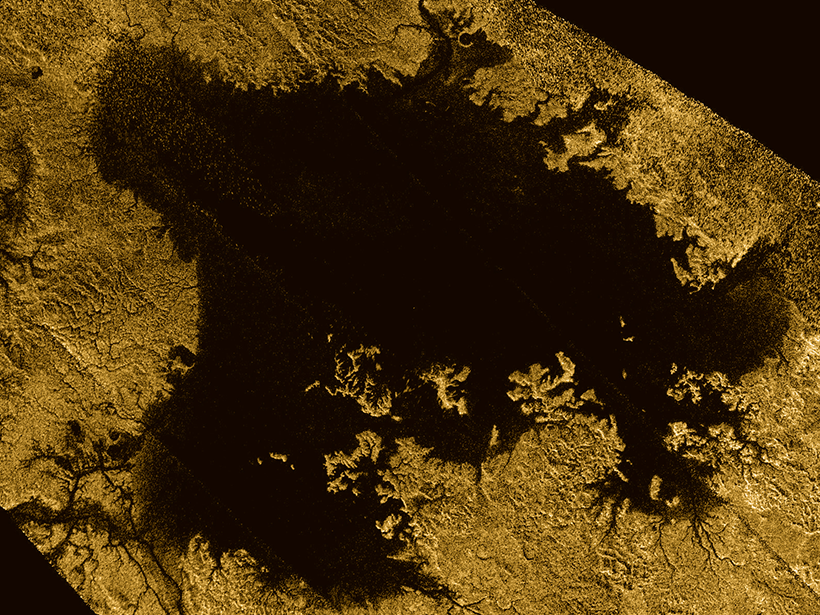In the game of habitability, only a small fraction of celestial bodies in our solar system competes for the title “most compelling.” There’s Saturn’s moon Enceladus with its watery jets and internal ocean, Jupiter’s moon Europa with another internal ocean, and even our rocky neighbor Mars with its icy poles and occasional water flows.
But Saturn’s largest moon, Titan, hiding under a haze of smog, just upped the ante. Researchers found a molecule called vinyl cyanide (C2H3CN) in Titan’s atmosphere. A collection of these molecules, should they rain down into Titan’s methane lakes, could link up to form membranous structures like the squishy walls of our cells, they say.
“Detecting this molecule in the atmosphere suggests that there should be a bunch of it available in [Titan’s] lakes,” said Maureen Palmer, a researcher at NASA’s Goddard Space Flight Center in Greenbelt, Md., and lead author on a new paper published today in Science Advances. Moreover, because this molecule exists in the atmosphere, “maybe there’s a higher chance of these membranes actually forming” in Titan’s polar lakes and seas.
Life as We Know It
Why even look for molecules that could form a tiny sac? Because life as we know it needs cells to thrive.
But why even look for molecules that could form a tiny sac? Because life as we know it needs cells to thrive.
On Earth, fatty molecules called phospholipids create membranes that enclose living cells (unless you’re a plant, in which case your cells have an extra, stiff layer called a cell wall). One end of each phospholipid molecule is attracted to water (hydrophilic), whereas the other end tries to avoid water (hydrophobic), causing groups of the molecules to stack together and form a flexible barrier. Our cell membranes safeguard the teeny structures required for life—like DNA—so the protective layer is pretty important.
Titan is the only body in the solar system other than Earth with liquid pooling on its surface and regular rainstorms, which makes it a good candidate for habitability. But there’s a catch: The liquid and rain are methane. What’s more, that liquid methane is cold, with temperatures dropping to about −180°C (the coldest place on Earth, in Antarctica, can dip to −92°C, but only at night).
In 2015, a team of researchers at Cornell University in Ithaca, N.Y., set out to determine what kind of molecule could form a cell membrane in these frigid lakes. They tasked computer models to look for molecules composed of, like most molecules in Titan’s atmosphere, nitrogen, hydrogen, and carbon. The molecules also needed to be partly methanophobic and partly methanophilic.
Those models spat out a molecule called acrylonitrile, or vinyl cyanide. Simulations showed that in liquid methane, vinyl cyanide molecules would form a spherical, flexible shell, much like phospholipids on Earth. The researchers named the proposed structure “azotosome,” meaning “nitrogen body” in Greek (as opposed to the word “liposome” for the sac around an Earth inhabitant’s cell, which means “oil body”).
Hunting for Vinyl Cyanide

In the meantime, Palmer and her colleagues were combing through Titan atmospheric data from the Atacama Large Millimeter/Submillimeter Array (ALMA) radio telescope in Chile to look for new molecules. Vinyl cyanide became their quarry.
Molecules in Titan’s atmosphere emit distinctive frequencies of microwaves, which ALMA can detect. Even though ALMA is on Earth, 1 billion kilometers from Titan, it is better at detecting these waves than instruments aboard the Cassini spacecraft currently exploring the Saturn system. Cassini has dipped as close as 1,000 kilometers from Titan’s surface, but its instruments aren’t sensitive enough to detect small differences in the microwaves coming from similar molecules, said Conor Nixon, a coauthor on the paper and planetary scientist at Goddard.
Think about your radio tuner, Nixon said. Cassini is like a radio that can differentiate between stations 88.5 and 88.6, whereas ALMA is like a radio that can differentiate between 88.5 and 88.50001—that’s 10,000 times more sensitive.
Chemical reactions necessary to forming a cell membrane could be occurring on Titan right now.
The ALMA data revealed that Titan’s atmosphere may be composed of about 3 parts per billion vinyl cyanide, which the researchers postulate could rain down into Titan’s northern lakes and seas. In fact, they calculated that if the vinyl cyanide rained into the lake Ligeia Mare—and no further chemical reactions altered the molecules—there could be around 10 million azotosomes per cubic centimeter in the lake. That number is comparable to the concentration of bacteria in Earth’s oceans, the paper’s authors say.
This means that chemical reactions necessary to forming a cell membrane could be occurring on Titan right now.
However, Nixon pointed out that scientists have yet to test in a lab what actually happens to vinyl cyanide in liquid methane. So far, researchers have modeled the outcome only in computer simulations.
“Somebody’s got to show us that this can happen,” he said, “and that it’s not just a theoretical concept.”
Cassini and Beyond
Results like this show us that Titan “has a lot to teach us about how organic chemistry works and the environments in the solar system where life may exist,” said Sarah Hörst, a planetary scientist at Johns Hopkins University in Baltimore, Md., who studies Titan’s atmosphere but wasn’t involved in the new research.
Both she and Nixon agree that the new ground-based observations of vinyl cyanide in Titan’s atmosphere show that although the Cassini mission ends this September, scientists will still have tools that can unlock mysteries of the hazy moon.
—JoAnna Wendel (@JoAnnaScience), Staff Writer
Citation:
Wendel, J. (2017), Could a newfound molecule on Titan be a building block for life?, Eos, 98, https://doi.org/10.1029/2017EO078695. Published on 28 July 2017.
Text © 2017. The authors. CC BY-NC-ND 3.0
Except where otherwise noted, images are subject to copyright. Any reuse without express permission from the copyright owner is prohibited.

